A New Environment by Wendell Castle at Friedman Benda gallery, New York
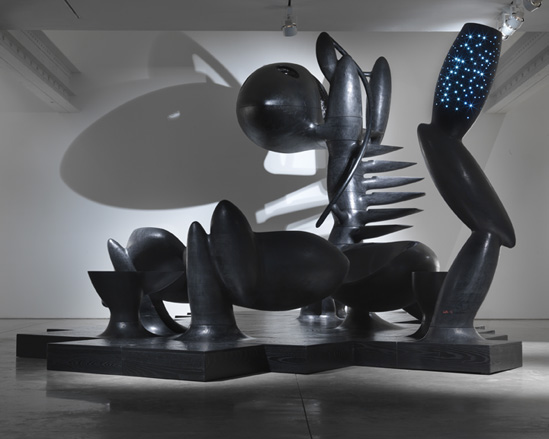
'I never thought about art when I was young, but I did like to draw' says furniture artist Wendell Castle, surveying his new exhibition at New York's Friedman Benda gallery. 'And when the neighbourhood kids were building a tree house or a fort, I would always be in charge.'
Fast forward seven decades or so and he's created the ultimate hideout: a streamlined pod that floats above a living room of sorts, with seating and a table. Castle flicks a switch and a totem-pole-like form casts a glow that makes his largest work to date appear to be made from onyx and obsidian rather than wood and fiberglass. The scene is both organic and otherworldly.
Having celebrated his 80th birthday in November, Castle shows no signs of slowing as he jumps up to demonstrate the sturdiness of the undulating staircase he crafted with the help of a 3D scanner. In addition to 'A New Environment' in New York, his fluid forms are the subject of two other exhibitions - at the Aldrich Museum in Ridgefield, Connecticut and the Kentucky Museum of Art and Craft in Louisville - and in April, the Artist Book Foundation will publish a catalogue raisonné of 1,700 works.
We caught up with him about his major new work and carving out a place between art, sculpture, and furniture design.
How did you get started making sculptural furniture?
I had a breakthrough while in graduate school [at the University of Kansas], although at the time I didn't realise it was a breakthrough. In sculpture class, I had a teacher who said sculpture is art and furniture is not. Confronted with that, I began to wonder, why is that true? So I made this piece that I called a chair, sort of a chair, and passed it off as sculpture. Later, after I had graduated, a professor at the Rochester Institute of Technology saw that piece in an exhibition in New York City and offered me a teaching job. When I first went up to Rochester, I continued to make sculpture, but then I realised that there was a field where people were considering themselves furniture makers of some special quality. And I thought, well, I can do way better than these guys. So I began to make furniture, using the laminated wood technique, which is exactly what I still use.
Why that technique?
It gave me opportunities to make furniture in a very different way than anybody else. I didn't invent lamination. Anybody who ever glued two boards together laminated. But what I brought to the table was the idea of large pieces with the cross-sections pre-planned, so that you band-saw out each layer to roughly its right size before you glue it on. That means that you can only glue one layer at a time, but then you can see the form developing and you can actually make some small changes. And you can make really big things. You just keep throwing the wood on.
Your work is distinctly organic. What influenced that?
I was thinking, why can't furniture be the same as sculpture, in terms of its value for collecting and trading - not the same as sculpture, but equal? With this idea in mind, I thought that my work should look like sculpture. Nowadays, you couldn't define what sculpture looks like, but it was easier in the 1960s and to me, Brancusi was the best. And Miro and Arp and Henry Moore, they did alright too. I liked those things - organic work and soft forms. And I still am working with soft forms today.
What led you to create this major new work, on such a grand scale?
In 1969, I made what I called an 'environment for contemplation,' a wooden chamber with a hinged door, and I had thought about creating another environment for a long time. But, for number one, you need an opportunity to exhibit it. You don't just make something like that and put it in your living room. Well, I had the opportunity with this gallery space. I wanted to do something that was somewhat like the one I did in the '60s, but I didn't want it to look or be the same. I wanted to make it much more dramatic, and I think hoisting it up in the air does this.
Where did the rest of the environment come into play, this floored area that the pod hovers over?
I really liked the idea of furniture that doesn't have legs in the traditional sense, and you can eliminate legs if you bolt 'em to the floor. I've done that a few times, but I've never put a grouping together before like I did with these three chairs in a kind of conversation setting. So I wanted to do things that grew out of the floor, particularly with the staircase. Normally, a staircase goes from one floor to another floor, and it's fastened at the bottom and it's fastened at the top, and everything's fine. Well, if you don't fasten it at the top, you've got a very different situation. The floor gave me an opportunity to hide some structural elements. That pod up there is heavy! It's fiberglass, probably around five or six hundred pounds. If we made it out of wood, which we had started to, it would have been about twice that.
And the pod itself - is that fur inside?
It's lined in a flokati rug. So it's totally upholstered, top and bottom, and that's very sound-deadening. If you were up there, you wouldn't hear us talking down here near the bottom of the stairs. You don't hear anything going on. We didn't put a door on this one, because really, there was no place to swing it open. And being up in the air, it's pretty private anyway. No one can peek in too easily. It's supposed to be a really private space. There's a reading light in there. And it would be easy to also put music in there too.
Besides the fiberglass pod and floor panels, this work is made entirely out of wood. Why did you choose this material?
It seemed right somehow. This particular wood is American ash, which is kind of blonde-coloured, not very interesting. But the interesting thing about it is that the grain is what we call open-grain, so when you stain it, you do not lose any of the grain. You actually see it even better.
Why did you choose to stain it black?
Because I really love black. It's my favourite colour. I think you see form very clearly in black.
Let's talk about process. How do you begin a piece like this?
I made a [urethane foam] model of the whole thing, and the model was pretty accurate. Then we scanned it with a 3D laser scanner, and that helped us to create patterns. Having those patterns was particularly important for something like the staircase, because every step is different. You can't interchange anything. So that digital information was helpful.
Do you work with a lot of automated tools?
We have just brought a robot into the studio - a six axis robot. And we'll be able to use that for parts, but not for everything. It will allow us some opportunities. Now it's possible to create shapes than you cannot get your tool into, and I might not want the fact that I can't get a tool in there to influence my design. The way to do it is to make some of these things in pieces, so they can be separated during the making and then glued together later. Then you can get into these difficult places and nest the pieces up much tighter. I don't think they'll look dramatically different, but there'll be situations that would be absolutely impossible to have done using traditional methods.

Made from wood and fiberglass, the scene is both organic and otherworldly
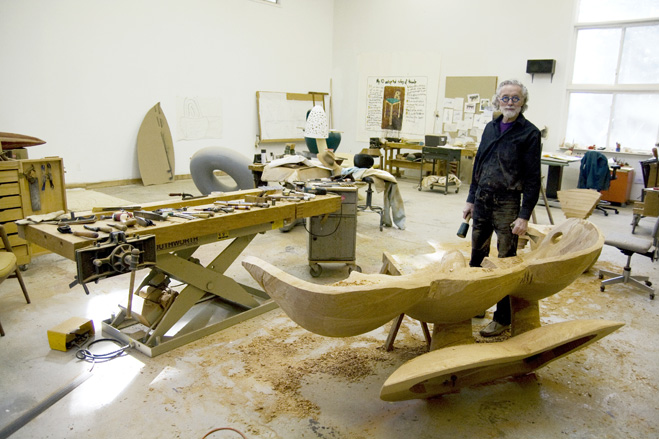
Castle, pictured at work in his studio

Crafting the totem
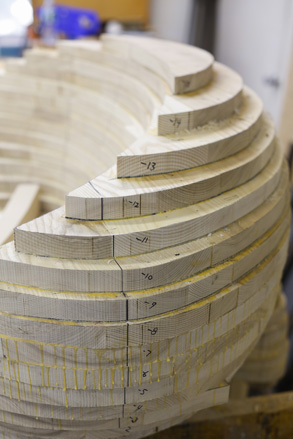
Castle uses a laminated wood technique to create his pieces
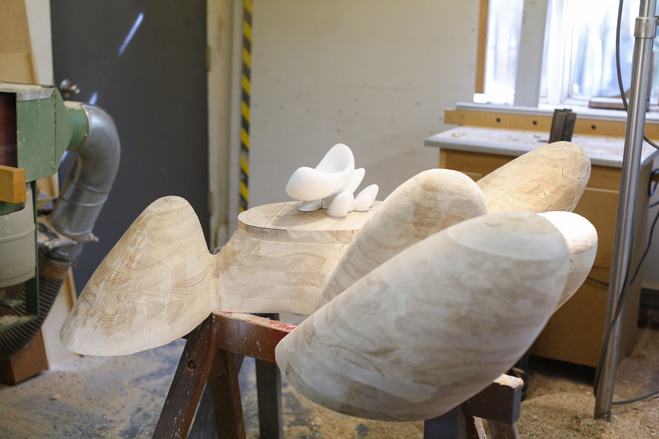
The technique allows him to 'make really big things. You just keep throwing the wood on'

The staircase was crafted with the help of a 3D scanner

The pod is lined in a sound-absorbing Flokati rug. 'No one can peek in too easily. It's supposed to be a really private space,' says Castle
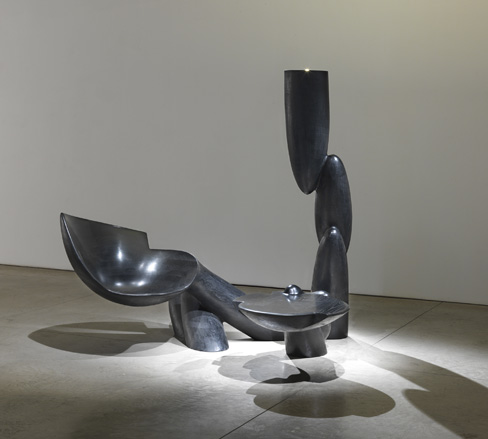
The works in the exhibition are crafted in American ash

The wood has been stained black. 'It's my favourite colour,' says Castle. 'I think you see form very clearly in black'

The wood grain is still clearly visible, despite the staining
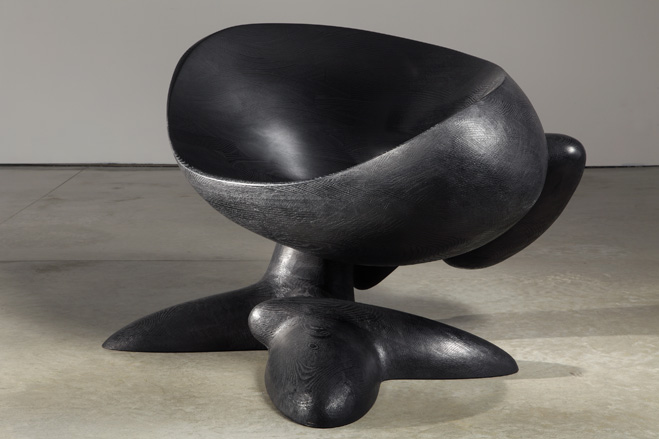
Castle's trademark soft forms distinguish all the works
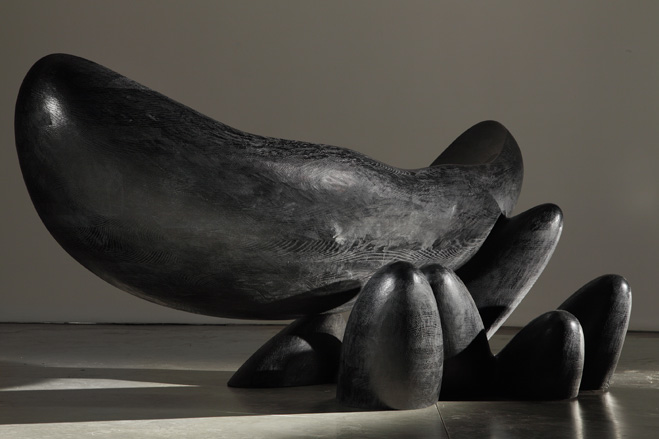
Another bolder-like sculpture
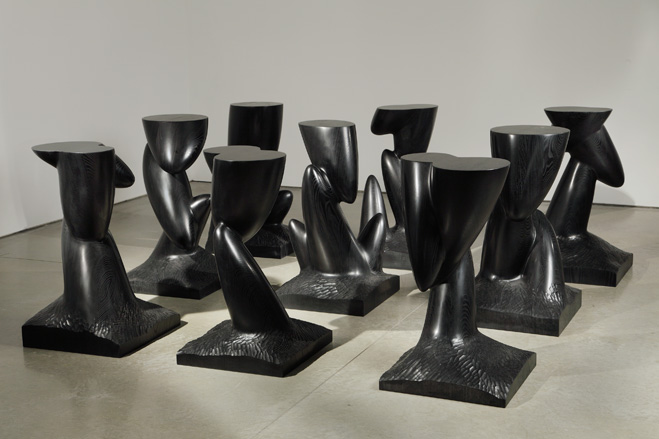
A collection of totems
ADDRESS
Friedman Benda gallery
515 West 26th Street
New York
NY 10001
Wallpaper* Newsletter
Receive our daily digest of inspiration, escapism and design stories from around the world direct to your inbox.
Stephanie Murg is a writer and editor based in New York who has contributed to Wallpaper* since 2011. She is the co-author of Pradasphere (Abrams Books), and her writing about art, architecture, and other forms of material culture has also appeared in publications such as Flash Art, ARTnews, Vogue Italia, Smithsonian, Metropolis, and The Architect’s Newspaper. A graduate of Harvard, Stephanie has lectured on the history of art and design at institutions including New York’s School of Visual Arts and the Institute of Contemporary Art in Boston.
-
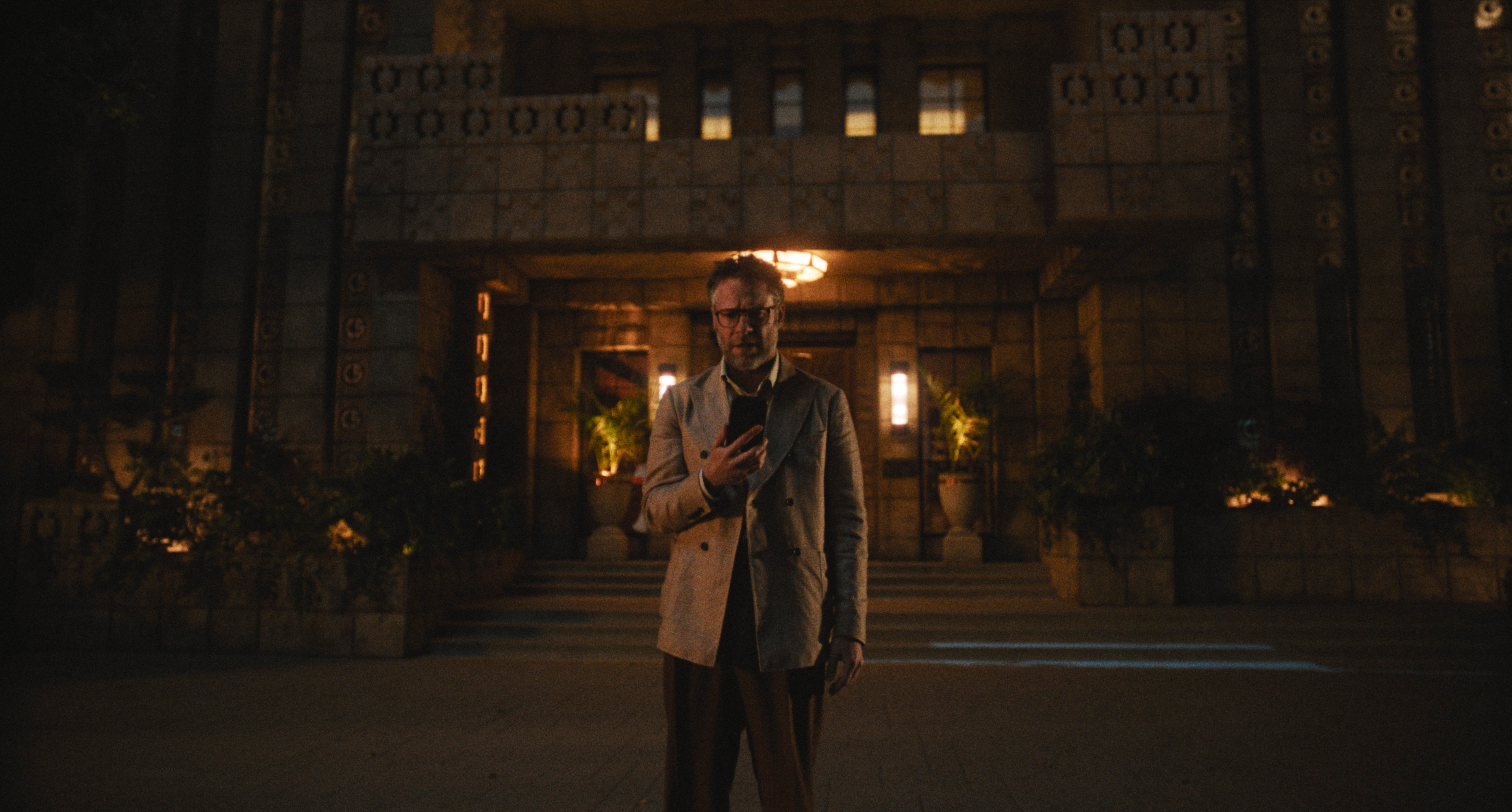 In Seth Rogan's 'The Studio', midcentury masterpieces are the star
In Seth Rogan's 'The Studio', midcentury masterpieces are the starThe AppleTV+ series features some architectural gems which eagle-eyed audiences will have recognised
-
 The Tate Modern is hosting a weekend of free events. Here's what to see
The Tate Modern is hosting a weekend of free events. Here's what to seeFrom 9 -12 May, check out art, attend a lecture, or get your groove on during the museum's epic Birthday Weekender
-
 Gallic automotive luxury and craft come to the fore in the unique Presidential DS N°8
Gallic automotive luxury and craft come to the fore in the unique Presidential DS N°8DS Automobiles has created a new conveyance for President Macron. This one-off DS N°8 continues a long tradition of supplying cars to the presidency